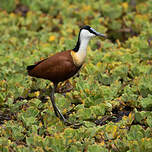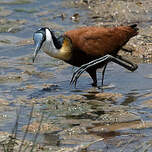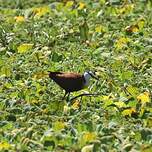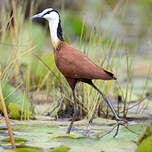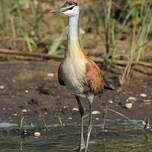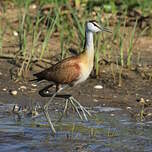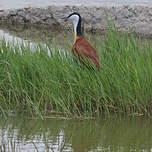African Jacana
Actophilornis africanus - Jacana à poitrine dorée
Identification
Although its physical appearance and some visual details could classify the African Jacana in the order of Gruiformes, it actually belongs to the order of Charadriiformes, and it is a monotypic species. A very beautiful water bird of just over 30 cm in height, its elegance immediately catches the eye. Its long, clear blue beak appears even longer because of the frontal plate of the same color. This beautiful blue part of the head is surrounded on each side by a black line that starts from the lores and goes around the eyes. This is followed by a large black line from the crown and down to the bottom of the neck, staying very thin at the level of the nape. The chin, throat, parotids, sides of the nape and upper chest are an immaculate white. The latter part becomes a light golden brown at the bottom. This gives the bird a very slender and elegant profile. The rest of the body is tawny-fawn with quite golden tones in full light. The rump and secondary remiges are slightly darker and the primary remiges are black. The bird's long legs and long fingers are gray-blue. There is no sexual dimorphism, however, the female is larger than the male.
The chick is tawny, striped with light and dark brown on top and white underneath. Its almost as long fingers make it look disproportionate. The juvenile does not have or has little of the blue frontal plate and the beak is not entirely blue. The black part at the back of the head in the adult is light brown in the juvenile and marked by a well-visible white eyebrow. A yellowish golden pectoral band separates the white chest in two. The upper parts are tawny and the lower parts are white.He has adult plumage at the age of one.
Subspecific information monotypic species
Foreign names
- Jacana à poitrine dorée,
- Jacana africana,
- jaçanã-africana,
- Blaustirn-Blatthühnchen,
- afrikai levéljáró,
- Lelieloper,
- Jacana africana,
- afrikansk jaçana,
- Afrikabladhøne,
- jakana modročelá,
- ostnák africký,
- Afrikansk Bladhøne,
- afrikanjassana,
- Grootlangtoon,
- jacana africà,
- długoszpon afrykański,
- Африканская якана,
- アフリカレンカク,
- 非洲雉鸻,
- afrikansk jaçana,
- 長腳雉鴴,
Voice song and call
Habitat
Commonly known as the Lily-trotter in English (water lily runner), this term characterizes its habitat well.
Behaviour character trait
The African Jacana is a gregarious bird, usually content with a limited habitat. However, in times of extreme drought, entire populations have been known to travel hundreds of kilometres in order to find a moist area where they can settle, since this biotope is essential for their survival.
They normally feed in pairs or loose groups using their long toes to delicately move over floating vegetation, looking for insects on the leaves which they sometimes turn over in order to root out their prey. They also take advantage of the backs of hippopotamuses to move around the surface of the water, walking or swimming from one patch of vegetation to another, and even diving if in danger. It is on this vegetation that the African Jacana also reproduces during times of plenty, differing from region to region but always during the rainy season. This species has developed a polyandrous reproduction system, with the female mating with multiple males and the males being the ones in charge of bringing up the chicks. Throughout this period the birds form couples or small groups.Flight
Dietfeeding habits
Reproduction nesting
Male African Jacanas shoulder most of the nesting responsibilities. Before attracting a female, they build a basic nest in the vegetation, made up of rotting algae or directly onto a large water lily leaf.
They also use large exotic fern leaves to build their nest, in order to avoid their destruction by plant-eating rodents. Once the nest is finished, they call for a female by cackling and throwing the nesting materials. The courtship begins with the female choosing a mate. It is brief and simply involves both birds walking in a circle, with their heads down, in order to best display their bright blue frontal patches. Before mating, the female adopts a crouching position and the male then mounts her back after some pecking. The female lays 4 light brown eggs with dark spots, which the male incubates from the third egg onwards for 21 to 26 days. During the day, the male incubates in 30 minute stretches, in between which he leaves to go foraging. During the hottest hours, he will stand over the eggs to keep them in the shade. The female, meanwhile, moves on to mate with other males, up to 4 times during the breeding season. At hatching, the male will remove the shells from the nest and, for 40 to 70 days, raise and protect the chicks, who feed themselves and are moved away to safety in the pockets made by the male's folded wings in cases of danger. The chicks are precocial - they can also plunge underwater to hide.Geographic range
Threats - protection
IUCN conservation status
concern
in the Wild
threatened
evaluated
The species is common and widely distributed. It is only locally threatened by the modification of its habitat, the rising of the water levels flooding its nests, the drainage of wet areas and the increase of livestock. The nest can be destroyed by the passing of nutrias and the chicks predated by aquatic serpents.
Sources of information
- IOC World Bird List (v15.1), Gill, F and D Donsker (Eds). 2025-12-07.
- Vol. 3 - Handbook of the Birds of the World, Josep del Hoyo-Andrew Elliott-Jordi Sargatal
- Encyclopedia of life,
- BirdLife International, BirdLife International
Other sources of interest
 Specification sheet created on
24/07/2023 by Nathalie Santa Maria
Specification sheet created on
24/07/2023 by Nathalie Santa MariaTranslation by AI Oiseaux.net
© 1996-2025 Oiseaux.net
- Accipitriformes
- Aegotheliformes
- Anseriformes
- Apodiformes
- Apterygiformes
- Bucerotiformes
- Caprimulgiformes
- Cariamiformes
- Casuariiformes
- Charadriiformes
- Ciconiiformes
- Coliiformes
- Columbiformes
- Coraciiformes
- Cuculiformes
- Eurypygiformes
- Falconiformes
- Galliformes
- Gaviiformes
- Gruiformes
- Leptosomiformes
- Mesitornithiformes
- Musophagiformes
- Nyctibiiformes
- Opisthocomiformes
- Otidiformes
- Passeriformes
- Pelecaniformes
- Phaethontiformes
- Phoenicopteriformes
- Piciformes
- Podargiformes
- Podicipediformes
- Procellariiformes
- Psittaciformes
- Pterocliformes
- Rheiformes
- Sphenisciformes
- Steatornithiformes
- Strigiformes
- Struthioniformes
- Suliformes
- Tinamiformes
- Trogoniformes


























